These articles were written by our current president, Norm Kern, several years ago. They tell of his journey from a young kid in the late 1950’s through his early adult life in the 1960’s and how 2-wheeled transportation has played a part in almost everything in his life. I hope you enjoy them as much as I have…Patrick M.
Kickstart I was about the scooter craze in Ohio in 1958, which I mostly missed because I was a few days too young. In Kickstart II, I got my first motorcycle and discovered a great sport.
In February 1966, I started to attend meetings at Dayton Motorcycle Club. The 305 Honda Superhawk was a great bike, but if the wind was blowing the wrong way, I still couldn’t even maintain the speed limit on the highway. Long hills were another hassle. The Aultz had bought a Honda 450 the previous summer and it was a struggle keeping up with him.
I thought I would buy a big enough bike that I would no longer think about having to trade up. Harleys were too big, crude and expensive for my taste. I remembered how my boyhood friend was treated at the Harley shop. When he complained about the high price of parts that were constantly needed, the dealer’s reply was always, “Well, if you can’t afford to ride a Harley Davidson….” One day I saw an ad in the newspaper classifieds. Bonner Motors in Miamisburg had a used 750cc Norton Atlas for sale. I looked at it and fell in love. I sold the Honda and bought the Norton.
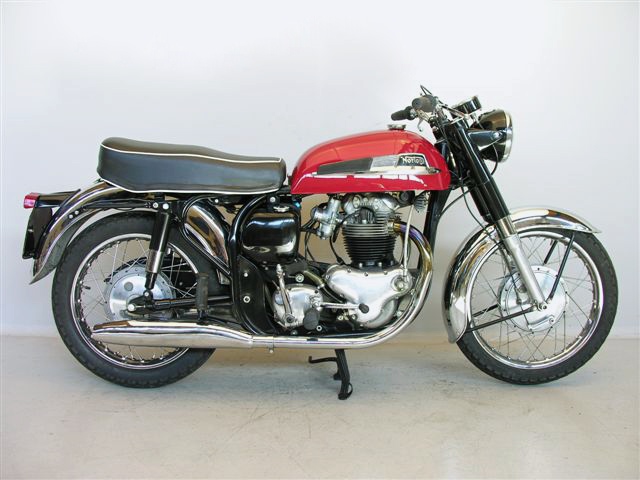
My education began immediately. I picked it up on a Saturday morning in late March and immediately rode it from Dayton to Cincinnati to show it to the Aultz. I thought I dressed warm, but the temperature was in the mid thirties. Unlike the little Honda, the big Norton had plenty of power and the wind didn’t slow it down. I arrived at the Aultz’s half-frozen. My arms ached and felt like they had stretched about two feet from holding on. I stood on a heat vent for about two hours to get warm before riding home. I already knew some basics. I had started wearing a Snell approved Arai helmet with a face shield only a few weeks after I started riding. In my first season, I also bought a leather racing shirt and engineer’s boots.
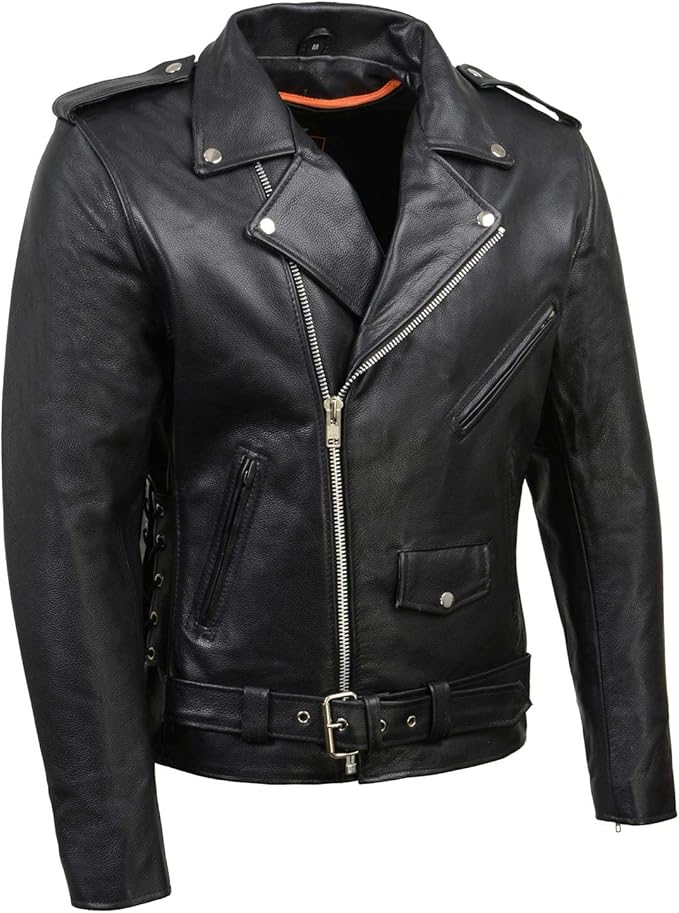
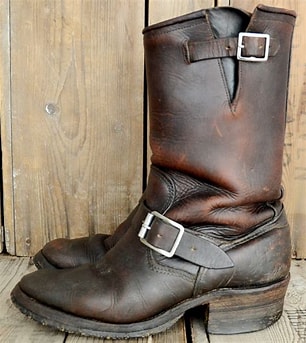
The first thing I bought for the Norton was a short windshield- I didn’t care how uncool it looked because it cut the wind and increased my comfort. The Norton used a Lucas magneto for ignition. It ran at half crankshaft speed, so the spark was very weak at kickover speed. Spark plugs had to be gapped at .016” and you had to know the cold starting drill. Turn on the fuel tap, tickle the float bowls till gas comes out, apply the choke only in very cold weather, give the throttle about 1/8 turn, ease to compression stroke, then kick for all you’re worth. Even in cold weather, I could always get going in three kicks or less, and most of the time it was a one-kick affair. You may think that I left out the step of turning on the ignition. Not true. There was a light switch, but only a kill button for the ignition. Security? A fork lock. I added a toggle switch to short the ignition and mounted it behind the frame tube on the battery box.
That spring, Gary Moore joined the motorcycle club. He had an old BSA that he claimed was the best motorcycle ever made. Soon, he bought a Norton Atlas, which now became the best bike ever made. Gary loves arguing and bragging. One night at the club he was boasting about how easy his Norton was to start, so a couple of us went outside and switched his spark plug leads. When he left about half an hour later, about six of us went out to watch him start his bike. It was a warm night, but Gary was suited up in his leather jacket and helmet as he kicked his bike. After about 7 or 8 kicks, Gary was starting to get mad. After about 20 kicks, he took off his jacket. I’ll never forget everyone shouting in unison, “twenty-seven, twenty-eight, twenty-nine.” At that point I couldn’t let him suffer any longer. I suggested that he might want to check his spark plug leads. If looks could kill… He had turned on the choke and the engine was mildly flooded, so it took awhile before it started. Gary roared down Bustass Lane, spraying gravel everywhere.
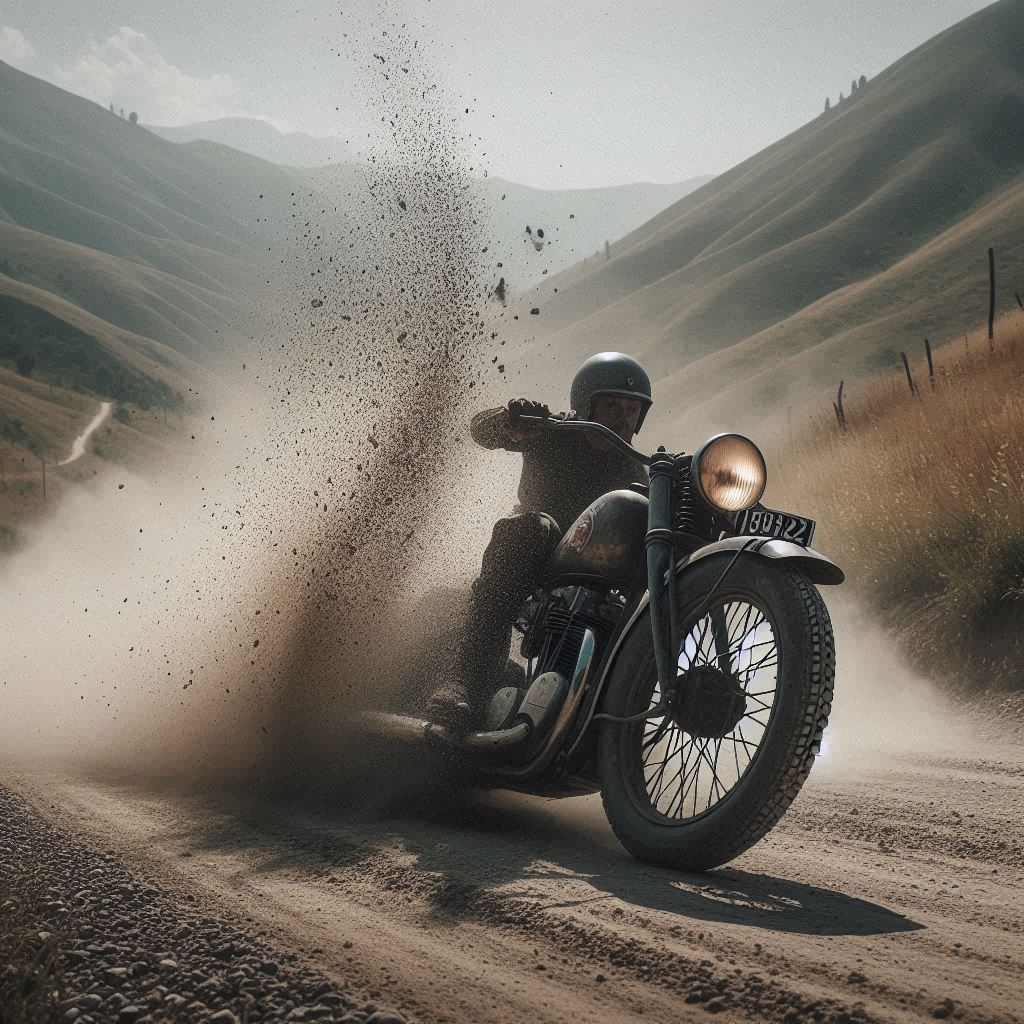
My Norton generated speeding tickets with ease, but the thing I was least prepared for was vibration. Redline was about 6500 RPM, and if you revved the engine that high with the headlight on, the lamp would probably blow. I replaced the Lucas (yeah, I know) headlamp with a sealed beam, which was more rugged. The taillight was mounted in rubber, so it didn’t blow, but the ground wire broke every few weeks. I discovered that the large bolt that fastened the cylinder head to the frame was broken off. I replaced it and within three weeks, it was broken too. I tapped out the head and replaced the original bolt with a 5/8” diameter bolt. That stayed put but didn’t help the vibration much. Vibration became a major enemy. Besides making the handlebar feel about two inches in diameter at 70 MPH, it made things come loose. British bikes of the time used Whitworth fasteners, which required special wrenches. I got my money’s worth from the sockets and wrenches I bought. Loctite was essential. I believed that if I could just get everything tightened up right once, then it would be fine. What I discovered was that if you got it tight enough that it wouldn’t come loose, it would probably break, and lots of things did.
I won’t go through all the things that broke, but here are the highlights. Timing side main bearing-broken cage. Alternator stator-shorted. Alternator rotor-loose on hub. Cracked cylinder base flange. Two primary chains. Gas tank leak- cracked. Speedo and tach drive boxes fell apart. The oil tank cracked. The luggage rack broke many times. Exhaust pipe nuts came loose every week or two. Zillions of clutch cables. When the Aultz first had his Zundapp, he taught me one of motorcycling’s fundamentals of the time- you must always have a good bike rag with you to wipe off dirt or oil. I hardly needed the little orange rag with the Honda, but I went through a lot of them with the Norton. I had to work on the Norton before and after every long ride. If I went 50 or 100 miles on the interstate, the bike wouldn’t idle the same when you stopped. You were always listening for signs of trouble, and they usually were there. I never got to see how fast the Norton would really go because the vibration at high speed was so great the fuel in the carburetor float bowls would froth and the engine would start to sputter.
Was the Norton a miserable experience? No, because when it was running well it was fast, and the handling was fabulous for the time.
One of the best rides of the summer was with the Aultz on the back roads of Kentucky. We were in the eastern part of the state and did not have a map. We came across a nice little road which had a four-digit route number. As we rode, the road got narrower and narrower. Before long it was only one lane, then there were some weeds growing in the middle. We had gone such a long way that we didn’t want to turn back. About the time it turned into two dirt paths, we encountered a kid standing by the road and stopped to ask directions. He said, “Yeah, it goes through to the main road, but it’s awful rough. There’s rocks back there this big around!” His hands were about a foot apart. Of course, we pressed on. The road followed a creek bed through a canyon, then crossed the creek. There was no bridge at the crossing, and the boulders were just the way the kid described. Fortunately, we didn’t have to go over the biggest ones, but our frames and pipes were crunching and banging on the rocks. The other side of the creek was higher ground and smoother, but then we came to a bridge, which consisted of two I-beams across a ditch with two by sixes across them. The problem was that the first three boards were missing. We took turns helping each other guide our wheels across the I-beam. Next, we hit deep soft sand in a curve and almost went down. Finally, we rounded a bend and there was the main road, with smooth pavement, centerlines, and everything. Later we studied maps but were never able to figure out where we had been. Nevertheless, it was a fun and memorable experience.
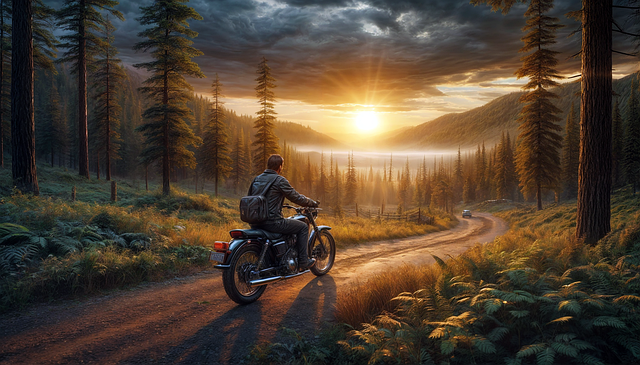
Early the next year, I had my first encounter with a car. A little old lady turned left in front of me as I approached an intersection at about 40 MPH. I hit the brakes and probably knocked off about 20 MPH before I scored a square hit to the right front door of her station wagon. I stood up as I flew forward and the front wheel collapsed. The windshield caught my chest, and the handlebars twisted, absorbing some of the impact. The forehead of my helmet hit the luggage rack of the car. As the forks sprang part way back, the bike rebounded about six feet back. As the bike fell over on the right side, I rolled off. I jumped up and ran for the car- I was ready to fight. The lady stopped right away, asked me if I was all right and said that she was sorry, and her insurance would pay for my bike and any injuries. My full leathers did a good job. I had a one-quarter inch square abrasion on one knee and some aches and pains that went away in a few days. Competition Accessories replaced the fork tubes, fender, wheel, etc. on the front of my bike. The insurance company settled. Unfortunately, they overlooked some significant damage. The first time I hit the brakes hard enough to compress the front forks, I found I couldn’t steer. I finally figured out what was wrong- the steering head was bent, and the front fender was touching the frame when the suspension was compressed. On careful examination, I found the steering head was not twisted, just bent to decrease the rake. I removed the front end, placed a large steel bar through the steering head, and pulled it back with a come-a-long. A mounting lug that had to line up showed me exactly how much to bend the steering head, and the repair was successful.
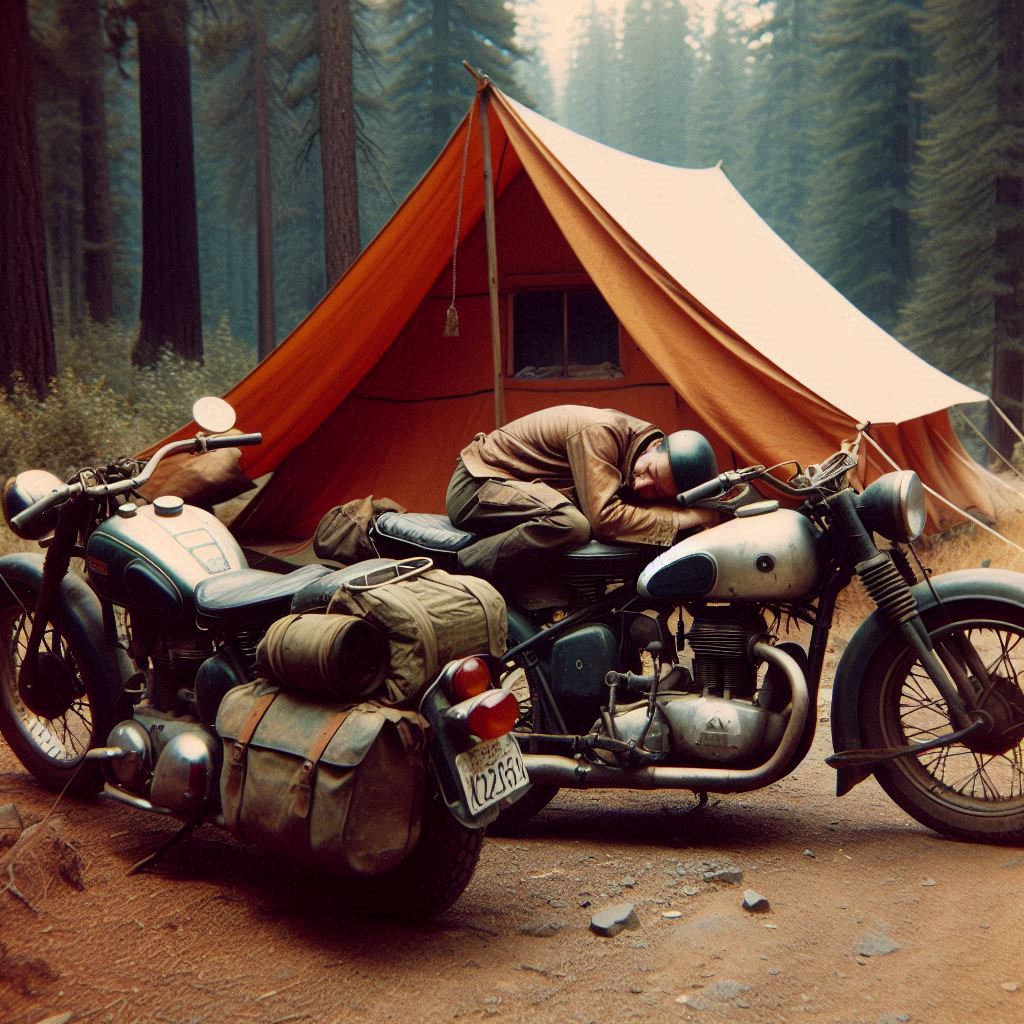
Later that spring I went on a weekend camping trip to Brown County, Indiana. I had my fiancé with me as well as the Aultz. Patti and I planned to sleep in my two-man pup tent while the Aultz would sleep on the ground in his mummy bag. We had dinner in a small town outside the State Park and brought some beer back to camp with us. Patti and I pitched the tent and got our sleeping bags out. We finished the beer and as the campfire died out we went to bed. About two AM, we were awakened by the Aultz. A cold front had moved in, dew was falling, and he was freezing to death in his mummy bag. He wanted to come in the tent with us. The three of us spent the rest of the night crammed into my tiny tent. No one could move and we were forced to sleep on our sides. It was not a restful night. The next morning it was cloudy and cold, but we pressed onward. The first time I tried to shift down from high gear, I discovered the shifter was not working right. We stopped at the side of the road, leaned the bike over so the gear oil wouldn’t run out and pulled the transmission cover. The spring for the ratchet pawl was broken. I found a coat hanger at the side of the road and made a spring, but it didn’t work very well, so we headed home. I stayed in third gear until I got on I-75 north of Cincinnati. Before long there was oil everywhere and I was losing power. It was time to call home and get my dad with the trailer. Later I learned the problem was a cracked piston. When I rebuilt the motor, the dealer could not get a copper head gasket, and he assured me that a composition one would be OK. This was bad advice, because the next time I went out on the highway, the bike quickly lost power and stopped. Kicking it I could see there was no compression in either cylinder. Back on the trailer. I later learned that the head gasket had blown between the cylinders. There is only about one quarter inch between the cylinder bores and there is no head bolt nearby, so a copper gasket is essential. Why did they even sell composition head gaskets?
The top ten lessons from Motorcycle Ed 101
10. You need to dress warmer than you think in cold weather.
9. Big bikes need windshields.
8. Vibration is the enemy.
7. All the jokes about Lucas Electrics are true.
6. British bikes require a good bike rag.
5. Chains can be a maintenance hassle.
4. Turn your headlights on for safety.
3. Don’t settle insurance claims too quickly.
2. The Aultz needs his own tent.
1. Nortons are fun to ride and tinker with, but not a good choice for daily transportation or long distances.
Next time: Motorcycle Ed 102- From Sport to Touring
